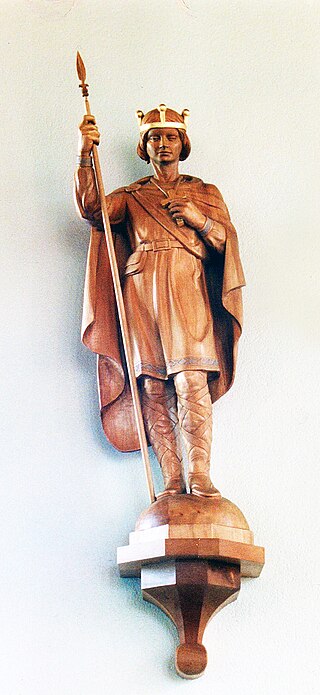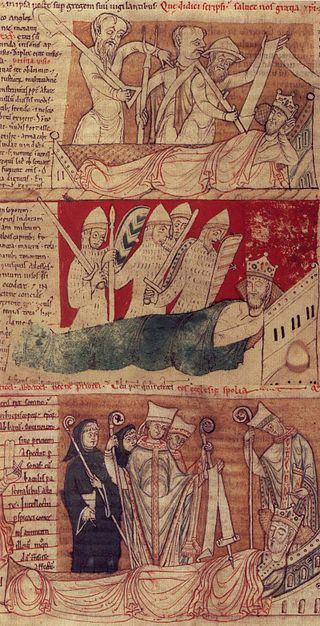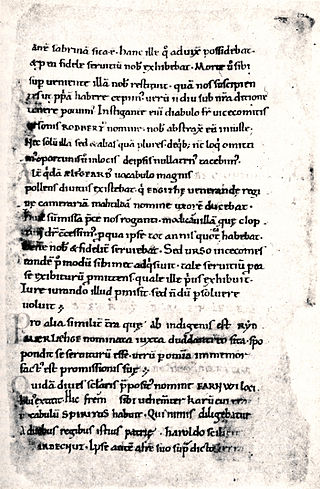Related Research Articles

Matthew Paris, also known as Matthew of Paris, was an English Benedictine monk, chronicler, artist in illuminated manuscripts, and cartographer who was based at St Albans Abbey in Hertfordshire. He authored a number of historical works, many of which he scribed and illuminated himself, typically in drawings partly coloured with watercolour washes, sometimes called "tinted drawings". Some were written in Latin, others in Anglo-Norman or French verse. He is sometimes confused with the nonexistent Matthew of Westminster.

The Annales Cambriae is the title given to a complex of Latin chronicles compiled or derived from diverse sources at St David's in Dyfed, Wales. The earliest is a 12th-century presumed copy of a mid-10th-century original; later editions were compiled in the 13th century. Despite the name, the Annales Cambriae record not only events in Wales, but also events in Ireland, Cornwall, England, Scotland and sometimes further afield, though the focus of the events recorded especially in the later two-thirds of the text is Wales.

The Flores Historiarum is the name of two different Latin chronicles by medieval English historians that were created in the 13th century, associated originally with the Abbey of St Albans.

Winchcombe is a market town and civil parish in the Borough of Tewkesbury in the county of Gloucestershire, England, it is 6 miles (10 km) north-east of Cheltenham. The population was recorded as 4,538 in the 2011 census and estimated at 5,347 in 2019. The town is located in the Cotswolds and has many features and buildings dating back to medieval times. In 2021 it was the primary strike site of the eponymous Winchcombe meteorite.

The Annals of Inisfallen are a chronicle of the medieval history of Ireland.

Saint Kenelm was an Anglo-Saxon saint, venerated throughout medieval England, and mentioned in the Canterbury Tales. William of Malmesbury, writing in the 12th century, recounted that "there was no place in England to which more pilgrims travelled than to Winchcombe on Kenelm's feast day".
W. de Wycombe was an English composer and copyist of the Medieval era. He was precentor of the priory of Leominster in Herefordshire. It is possible that he was the composer of one of the most famous tunes from medieval England, Sumer is icumen in.

Oswald of Worcester was Archbishop of York from 972 to his death in 992. He was of Danish ancestry, but brought up by his uncle, Oda, who sent him to France to the abbey of Fleury to become a monk. After a number of years at Fleury, Oswald returned to England at the request of his uncle, who died before Oswald returned. With his uncle's death, Oswald needed a patron and turned to another kinsman, Oskytel, who had recently become Archbishop of York. His activity for Oskytel attracted the notice of Archbishop Dunstan who had Oswald consecrated as Bishop of Worcester in 961. In 972, Oswald was promoted to the see of York, although he continued to hold Worcester also.

Byrhtferth was a priest and monk who lived at Ramsey Abbey in Huntingdonshire in England. He had a deep impact on the intellectual life of later Anglo-Saxon England and wrote many computistic, hagiographic, and historical works. He was a leading man of science and best known as the author of many different works. His Manual (Enchiridion), a scientific textbook, is Byrhtferth's best known work.

John of Worcester was an English monk and chronicler who worked at Worcester Priory. He is usually held to be the author of the Chronicon ex chronicis.

The Chronicles of the Kings of Mann and the Isles or Manx Chronicle is a medieval Latin manuscript relating the early history of the Isle of Man.
Brenhinoedd y Saeson is the medieval title of a Middle Welsh annalistic chronicle. The name means 'the kings of the English'.

Hemming's Cartulary is a manuscript cartulary, or collection of charters and other land records, collected by a monk named Hemming around the time of the Norman Conquest of England. The manuscript comprises two separate cartularies that were made at different times and later bound together; it is in the British Library as MS Cotton Tiberius A xiii. The first was composed at the end of the 10th or beginning of the 11th century. The second section was compiled by Hemming and was written around the end of the 11th or the beginning of the 12th century. The first section, traditionally titled the Liber Wigorniensis, is a collection of Anglo-Saxon charters and other land records, most of which are organized geographically. The second section, Hemming's Cartulary proper, combines charters and other land records with a narrative of deprivation of property owned by the church of Worcester.

The Anglo-Saxon Chronicle is a collection of annals in Old English, chronicling the history of the Anglo-Saxons.
The Gesta Pontificum Anglorum, originally known as De Gestis Pontificum Anglorum and sometimes anglicized as The History or The Chronicle of the English Bishops, is an ecclesiastical history of England written by William of Malmesbury in the early 12th century. It covers the period from the arrival of St Augustine in AD 597 until the time it was written. Work on it was begun before Matilda's death in 1118 and the first version of the work was completed in about 1125. William drew upon extensive research, first-hand experience and a number of sources to produce the work. It is unusual for a medieval work of history, even compared to William's other works, in that its contents are so logically structured. The History of the English Bishops is one of the most important sources regarding the ecclesiastical history of England for the period after the death of Bede.
Germanus was a medieval English abbot and Benedictine monk. He travelled to Rome in about 957 and became a monk at Fleury Abbey in France. Back in England by 964 he served as a monastic official before being named abbot of Winchcombe Abbey in about 970, a position he was removed from in 975. Germanus may have become abbot of Cholsey Abbey in 992.
The Winchcombe Annals, sometimes known as the Later Winchcombe Annals, are a Latin chronicle compiled c. 1240 by an anonymous monk at the Benedictine abbey, Winchcombe Abbey.
The Coventry Chronicle is a 12th-century world chronicle in annual format covering the period from the Creation to the year 1122.
The Chronicle of Saint-Pierre-le-Vif of Sens is an anonymous Latin chronicle written at the Abbey of Saint-Pierre-le-Vif in Sens between about 1100 and 1125 with continuations added into the 13th century. The original work was attributed to a monk named Clarius by Dom Victor Cottron in 1650, but this is not now accepted. It is, however, sometimes still labeled the Chronique dite de Clarius. The Chronicle is mainly a history of the abbey and of the city of Sens.
Reginald Ralph Darlington, FBA, FSA, FRHistS was an English historian.
References
- ↑ Hayward, Paul Antony.,The Winchcombe and Coventry Chronicles: Hitherto Unnoticed Witnesses to the Work of John of Worcester, The Medieval Review 12.02.12.
- ↑ Antonia Gransden, Legends, Tradition and History in Medieval England(Bloomsbury Publishing, 2010) p233.